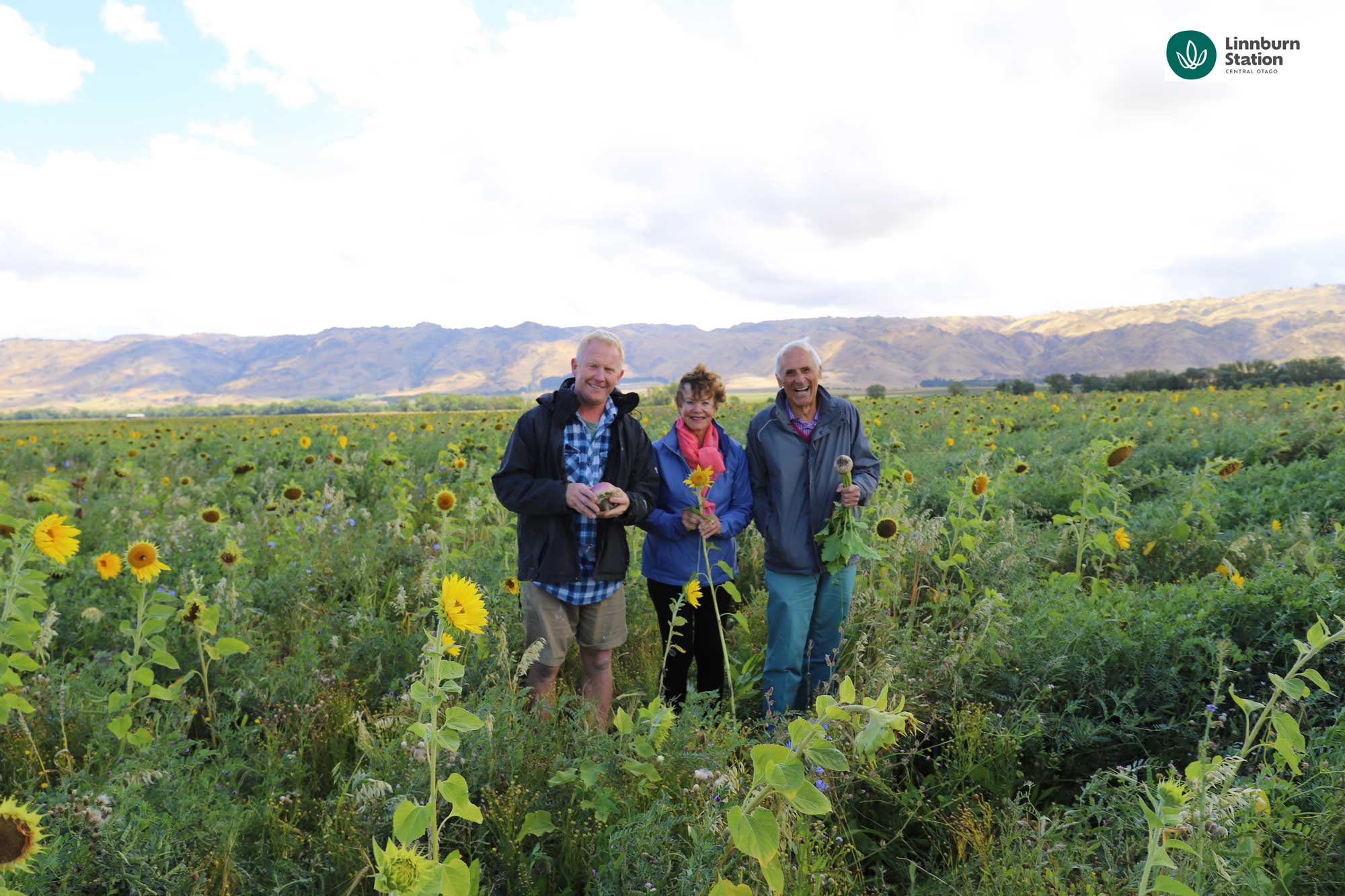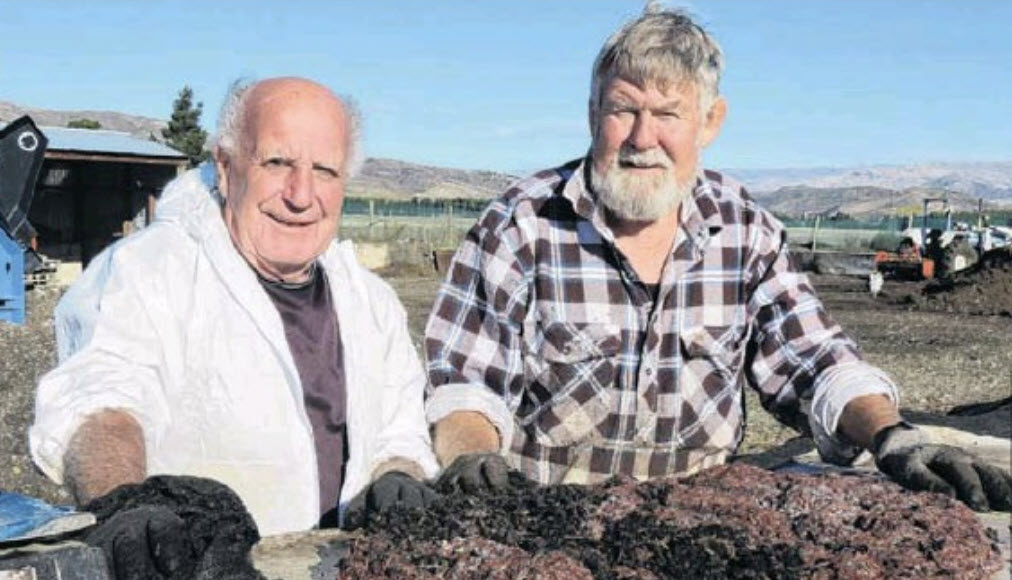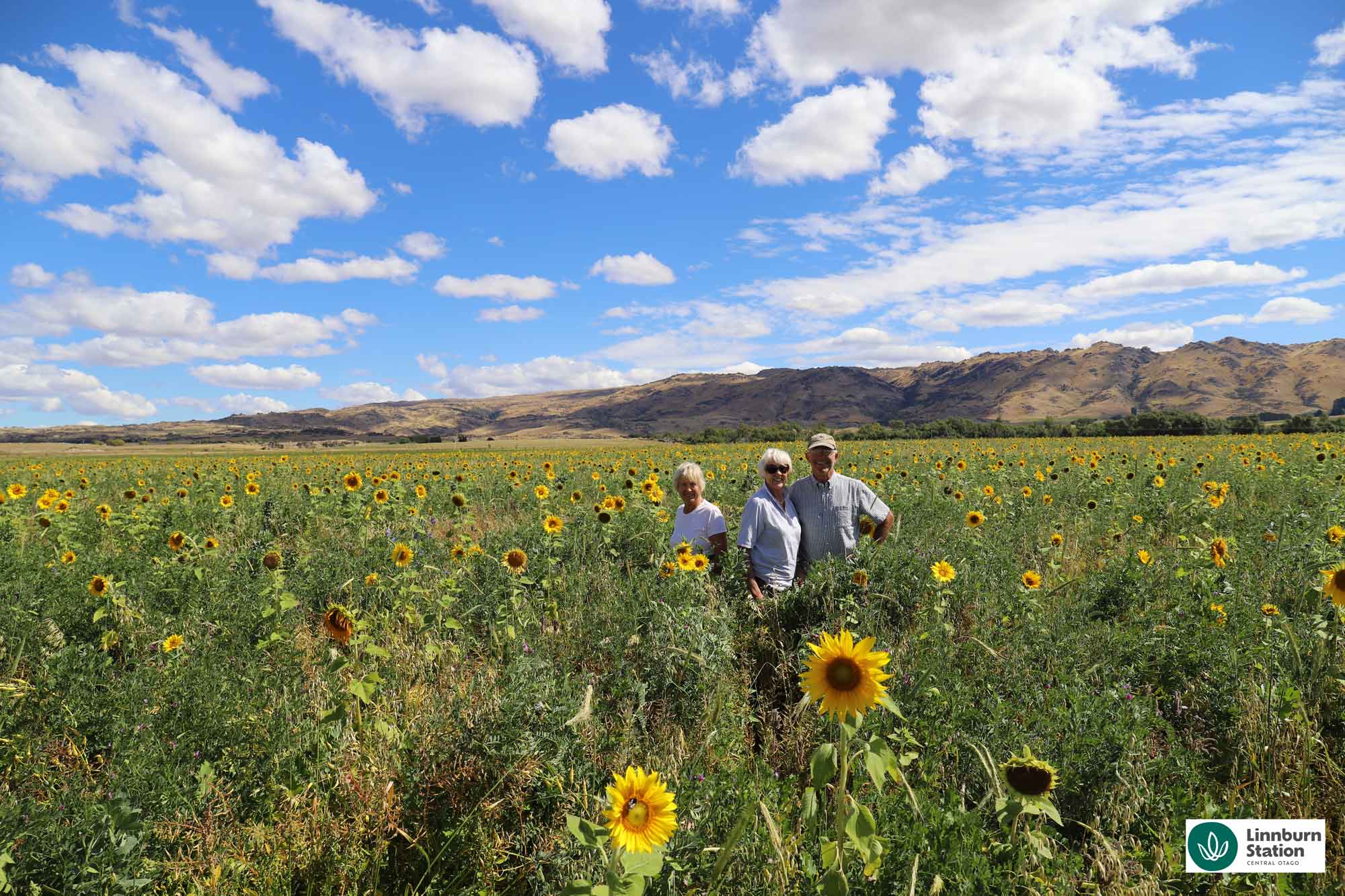
Regenerative agriculture: Thinking differently about farming
NZ Herald 25th July 2020
Farmers in the Gisborne region were invited to a presentation from Peter Barrett and Jono Frew about ways to regenerate the land used for farming. The Gisborne Herald’s Matai O’Connor went along to learn about regenerative agriculture.
Imagine putting 30 different species of plant into the same acre and then letting stock live in it. Well that’s what Linnburn Station’s Peter Barrett has done to help regenerate his land. Linnburn Station appeared on a recent episode of Country Calendar where he shared his story about regenerative agriculture. Jono Frew was born in Dunedin and grew up in Duntroon, North Otago, in a family of agricultural spraying and sheep-dipping contractors. Both created the company Symbiosis which is about sharing information on what regenerative agriculture is and educating people about the attributes of each plant species and providing seed mixes to farmers.
 They presented to farmers at the Patutahi community hall last week.
They presented to farmers at the Patutahi community hall last week.
Jono has worked in dairy, arable and sheep and beef, becoming an award-winning farm manager when managing 200ha organic mixed-cropping sheep and beef farm Harts Creek Farm(HCF). At HCF Jono started to question a lot of the current best practice and the way he had farmed his whole life. In 2018 Jono co-founded “quorum sense”, a forum created to bring innovative farmers and academics together to share knowledge and support farmers from the ground up. After three years at HCF, Jono decided that he needed to offer people access to relatable and practical knowledge and support in the regenerative agriculture space. And with his profound experience and a fresh perspective, Jono created Natural Performance Ltd and got to work supporting farmers all over the world.
Jono is committed to empowering and supporting people interested in producing nutrient-dense food, educating youth at schools and universities, and providing energy, connection and leadership to shift the paradigm of food production to one aligned with nature. “One that increases the health and resilience of our soil, plants, microbes, insects, animals, people and the ecosystem in all its complexity,” Jono said.
The main point of the presentation was about making farmers think differently and changing perspectives on how to do things, Jono says. “The old ways of farming are about using monoculture crops and controlling any other plant species and insects that grow on the land. “When I’m speaking about this it is coming from a background of me doing the work, not just some hippy thinking they know what works. “That clean, monoculture way of farming is keeping us so susceptible to all the elements.”
“It’s not something you can contain in a box — it’s an umbrella with different tools lying underneath.” “Some of those tools fall into conventional agriculture and some fall into an ‘organic’ category, but it’s about using the different tools that will support your ecosystem and push the system further forward,” Jono said.
The main focus of regenerative agriculture is biology. An important part of biology are mycorrhizal fungi — fungi that develop a symbiotic relationship with 90 percent of plants on the planet. “They are essentially an extension of the plant,” Jono said. They grow one cell at a time linking plants together, mobilising elements and storing them within the source. “You should keep them in your soil as they are a living organism — every time you step on soil, you’re stepping on 3000 miles of fungi. They link together to help transport important nutrients.”
This means using fungicide to kill fungi is not helpful for the biology and regeneration of the land. Plant diversity and microbial diversity are important for land to regenerate and do what it naturally does. “Root mass and growth is important. Leaving more natural growth on the land doesn’t mean it’s a problem.” Jono showed a picture of plant roots that were covered in soil. “These are called ‘rastafarian’ roots — if you have that on the roots then you have a biological relationship with the plants, which means you can rely on the plants to get what they need from the soil.”
Soil is important as it houses all the biology that plants need to grow healthy and strong. “You don’t need to be taught what good soil looks, smells and feels like,” Jono said. “When you realise there’s more life in a teaspoon of the soil than there are humans on the planet and most of those are good for you — then, getting in there and eating a bit of soil is more beneficial than any supplement you could take.”
Peter Barrett started his journey into regenerative agriculture in 2012 when he decided to move and live on his family-owned farm, Linnburn Station, a 9300ha beef and sheep station in Central Otago. Linnburn Station has been in his family since 1944 and had been run using conventional farming practices. But when Peter took over the station he thought there must be a better way of doing things.
Peter is one of a growing number of New Zealand farmers experimenting with alternative farming that regenerates rather than depletes the soil and farm environment. “Regenerative agriculture is about providing ideas on how to make money go further and make yourself more profitable,” Peter said. “At Linnburn,we believe in regenerative agriculture and that healthy soil equals healthy water which equals healthy animals and people.” Early in his journey he did what Jono said and put his hands into the soil and smelt it. He knew it was not healthy — it was compacted.
A water infiltration test is a great way to see how much water soaks into the soil. It also tells you about how much air the soil holds and what the soil compaction is like. Peter looked at his land and saw it was full of thistles. He wanted to replicate how the tap root weeds worked in the soil. “We came up with a mix of sunflowers, radishes and other plants with tap roots to replicate what the weeds I was seeing were doing — so air could get into the soil profile,” Peter said. “It’s very simple. You just need to focus on putting seed in the ground.”
Once he diversified the plants he was growing, “all of a sudden worms turned up” which is a sign of good soil health. “We are happy about growing tall, diverse plants to keep the ground protected,” Peter said. He showed a video of 3500 lambs going through a regenerated paddock and flattening out the 70ha of plant life. “This is done to create an end result where the soil temperature increases by 2 degrees. “It keeps life functioning and allows the land to recover while keeping the soil protected from rain, sun and wind,” Peter said. This also allows soil to build up because of the 5 to 8cm cm of plant material.
“This has changed our environment. In the past you had to drill to get soil out to test but now you can dig into it with your hands. “It has allowed us to awaken our senses and trust our eyes instead of getting all this data about our farms. Trust what you see and experience . . . and think differently,” Peter said.
Regen agriculture spreads north
Farmers Weekly 1st July 2020
Regenerative agriculture seminars attracted capacity audiences in Northland last week to listen to Peter Barrett, of Linnburn Station, Central Otago, and fellow presenter Jono Frew.
Co-sponsor Bryce Manderson, of Avoca Lime, said four seminars in the north each drew an average of 100 people including beef and dairy farmers, horticulturists and lifestyle block owners.
Barrett and Frew hammered the basic principles of regenerative agriculture: limited ground disturbance, cover crops, diversity in plants and soil organisms, improved root and soil structure leading to increased soil depth, high grazing residuals and true recovery times. They warned against monocultures, over-worked and exposed soils, compaction and reliance on chemical fertilisers, fungicides and pesticides.
Barrett establishes up to 1000ha of cover crops annually with a cross-slot drill and a small amount of aerial application on the 9300ha Linnburn, which has some of the lowest rain in the country. He uses seeds of 20 to 30 pasture varieties, mostly annuals and bi-annuals, including tap-rooted, tall species, legumes, cereals and vetches.
The crops establish even in dry summer months, provide short-term rotational grazing for sheep and cattle and right conditions to establish underground biota. What limited rain falls is not wasted or evaporated but retained for root carbon feeding and plant breakdown building soil porosity. After rolling and crimping the residual cover Barrett sows perennials like lucerne, clovers and grasses.
“We use a lot of different varieties because we are not after perfection or domination by one or two species. Diversity of plants equals less dependency on other inputs,” he said. “We also encourage diversity because we don’t know all the answers.” Some low-rate glyphosate use clears the weeds before cover cropping but weeds are important indicators of soil and plant populations.
Livestock numbers have recovered to between 20,000 and 25,000 units and the sheep genetics has moved from Merinos to Halfbreds plus an Angus cow herd. Frew, a former farmer and agricultural chemical applicator, has a farming consultancy called Natural Performance. “We are moving from complicated simplicity to simple complexity. “We are constantly refining, changing, making mistakes, celebrating successes and recording our results. “We want to share our experiences and results with all those prepared to listen.”
Country Calendar The Regeneration Game
TVNZ Channel 1 Country Calendar April 2020

Linnburn are proud to have been on Country Calendar.
The Maniototo is one of the driest places in the country. “Sometimes we don’t get rain from July to February,” Peter says. Temperatures in the mid-thirties are normal in summer and it freezes in winter. Snow can come at any time of year.
Regenerative agriculture replaces monocultures with variety. Instead of ryegrass or clover, Peter plants up to 30 different species in a paddock among the rocks of his tussock country.
Different plants release different minerals into the soil. The deep roots of sunflowers allow water and air to penetrate and other plants to access minerals deeper in the soil. He uses biological primers such as seaweed to activate soil microbes and fungi.
Instead of spraying to kill last year’s crop, he flattens it with a crimping roller to create humus and plants the new seed-mix directly into the soil.
Not just a pretty postcard, Linnburn Station is home to 25,000 winter stock units. In fact, this is farming close the limits. Much of the terrain is exposed rocky high country and for the past two years, the already low mean annual rainfall has declined to just 170mm. Temperatures fluctuate from below zero to 40degC.
From the Ground Up
Otago Daily Times July 2019

We’ll need to feed extra billions by mid century while being kinder to the land and reducing planet-heating carbon emissions to zero. The challenge has prompted some to call for a great food transition. Maureen Howard talks to a farmer playing his part.
“It’s like cottage cheese, but black,” says Peter Barrett of the soil that lies beneath Linnburn Station, his 9300ha beef and sheep station at Paerau in Central Otago.
Above ground, depending on the time of year, sheep may be spotted grazing beneath the gaze of yellow sunflowers, surrounded by a mix of up to 30 other plant species.
Not just a pretty postcard, Linnburn Station is home to 25,000 winter stock units. In fact, this is farming close the limits. Much of the terrain is exposed rocky high country and for the past two years, the already low mean annual rainfall has declined to just 170mm. Temperatures fluctuate from below zero to 40degC.
Country Calendar Regenerative farming reaps benefits at Linnburn
Dominion Post April 2020

You don’t often hear people singing the praises of the common weed but for Peter Barrett, “Weeds are everything.”
It was when Barrett began farming regeneratively at Linnburn Station that he quickly learned the worth of this humble and much maligned plant.
Sheep farming 'poster boy' off to Australian conference
Otago Daily Times August 2018

He has been described a ”poster boy” for the future of New Zealand’s sheep industry.
But young Maniototo shepherd Dave Ingham (24) is quick to stress that agriculture is ”not just going out shifting break fences and drenching lambs”.
With a thirst to continually learn, Mr Ingham has headed to Australia this week as one of two Beef + Lamb New Zealand-sponsored sheep industry ambassadors.
He and fellow ambassador Katey Craig will attend the LambEx conference in Perth and travel between Melbourne and Adelaide looking at different farm systems with industry representatives from Australia and the United States.
Mr Ingham has worked at Linnburn Station since November, 2016 when he completed his studies at Lincoln University.
Farmers urged to put Worms to work
Otago Daily TImes May 2019

Sheep and beef farmer Peter Barrett, owner representative of Linnburn Station, Paerau, wanted to implement a natural, holistic/ regenerative approach to farming the 9000ha property, using biological stimulants, non-tillage and cover crops.
He bought 29 tonnes of worm castings last year to spread on some of the station’s paddocks at about 750kg/ha, and visited Wormworx to discuss establishing his own worm farm.
Mr Barrett also grows a cover crop, including sunflowers and about 30 other plant species, which provide shelter for the worms and encourages other insects and microorganisms to take up residence.
‘‘When we used synthetic fertilisers on the station, we saw no worms and the soil was challenged,’’ he said. ‘‘Everything composts down and enhances life.’’
He said it lifted the organic matter and carbon levels in the soil, using plants and organisms to take CO2 from the atmosphere and returning it to the soil as carbon.
Mr Barrett also adds fish hydrolysate, humates, soluble sea weed, lime and molasses to the mix.
Since introducing the castings and other ingredients, he has seen a rapid increase in soil life, bees and birds.
He introduced a no-tillage policy, preferring to direct drill instead of turning over the soil, which leaches carbon into the atmosphere.
‘‘The key thing in my mind is regeneration agriculture is gaining more momentum,’’ he said.

